Posted 4:11 p.m. Friday, June 17, 2011

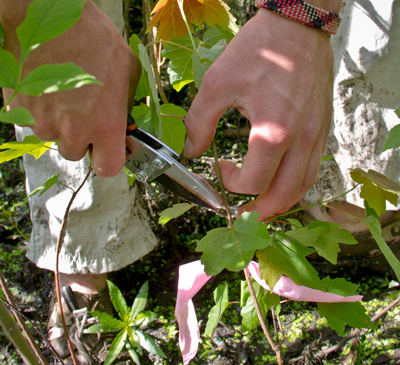 [/caption]
Meredith Thomsen trudges ahead, her mud boots sinking into black sludge. On a trail east of Goose Island, the UW-La Crosse biology professor can’t help but point to something new every few feet: a tree seedling’s red leaves, an over-sized tadpole splashing in a puddle and baby deer tracks freshly planted in the ground.
Those little animal prints are a sign the deer are dwelling here — a fact which both distresses and energizes the biologist. More deer means more destruction of young trees competing with other plants to survive in Upper Mississippi River floodplain forest. But it also means more fuel for her scientific research.
Thomsen and two biology students are documenting the growth of tree seedlings as part of a forest restoration project. The research is in collaboration with the US Army Corps of Engineers and the Upper Midwest Environmental Science Center.
The need for some biology expertise at the site east of Goose Island came after a 1998 storm blew down a huge section of the forest. Reed canary grass, an invasive species, began to grow.
[caption id="attachment_96" align="alignright" width="400" caption="Ben Cogger, a graduate student, sprays fence with natural chemicals."]
[/caption]
Meredith Thomsen trudges ahead, her mud boots sinking into black sludge. On a trail east of Goose Island, the UW-La Crosse biology professor can’t help but point to something new every few feet: a tree seedling’s red leaves, an over-sized tadpole splashing in a puddle and baby deer tracks freshly planted in the ground.
Those little animal prints are a sign the deer are dwelling here — a fact which both distresses and energizes the biologist. More deer means more destruction of young trees competing with other plants to survive in Upper Mississippi River floodplain forest. But it also means more fuel for her scientific research.
Thomsen and two biology students are documenting the growth of tree seedlings as part of a forest restoration project. The research is in collaboration with the US Army Corps of Engineers and the Upper Midwest Environmental Science Center.
The need for some biology expertise at the site east of Goose Island came after a 1998 storm blew down a huge section of the forest. Reed canary grass, an invasive species, began to grow.
[caption id="attachment_96" align="alignright" width="400" caption="Ben Cogger, a graduate student, sprays fence with natural chemicals."]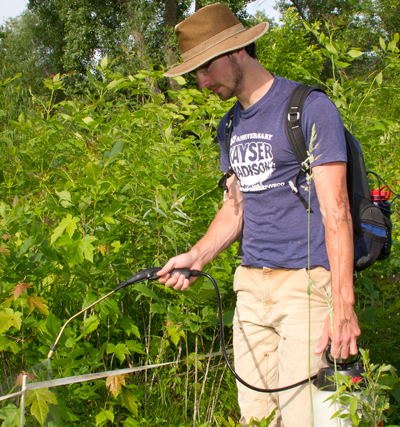 [/caption]
The grass pushed out the native Ash, Silver Maples and other tree seedlings. About five years ago, when Thomsen started as a biology professor at UW-L, the entire area was a blanket of the invasive grass. It was of particular concern to land managers because it destroyed an important habitat for many species of wildlife, says Randy Urich, forester with the US Army Corps of Engineers.
Moreover, natural blow-down events could occur in the future throughout the 23,000 acres of floodplain forest the Corps manages along the upper Mississippi River between Hastings, Minn. and Guttenberg, Iowa and the same story could play out over and over again, slowly converting what is currently forest into fields of reed canary grass, explains Thomsen.
Through research, the group successfully found a method to eliminate the invasive grass and now some of the young trees tower above Thomsen’s almost 6-foot-tall frame. But deer is another danger to the trees, which threatens the balanced ecosystem of the forest.
So Thomsen and the two biology students have joined forces in forest restoration. Ben Cogger, a graduate student in biology, is comparing fence types to see which could best protect tree seedlings from deer munching.
[caption id="attachment_87" align="alignright" width="400" caption="Ben Cogger, left, and Andrew Voelkel document tree growth. "]
[/caption]
The grass pushed out the native Ash, Silver Maples and other tree seedlings. About five years ago, when Thomsen started as a biology professor at UW-L, the entire area was a blanket of the invasive grass. It was of particular concern to land managers because it destroyed an important habitat for many species of wildlife, says Randy Urich, forester with the US Army Corps of Engineers.
Moreover, natural blow-down events could occur in the future throughout the 23,000 acres of floodplain forest the Corps manages along the upper Mississippi River between Hastings, Minn. and Guttenberg, Iowa and the same story could play out over and over again, slowly converting what is currently forest into fields of reed canary grass, explains Thomsen.
Through research, the group successfully found a method to eliminate the invasive grass and now some of the young trees tower above Thomsen’s almost 6-foot-tall frame. But deer is another danger to the trees, which threatens the balanced ecosystem of the forest.
So Thomsen and the two biology students have joined forces in forest restoration. Ben Cogger, a graduate student in biology, is comparing fence types to see which could best protect tree seedlings from deer munching.
[caption id="attachment_87" align="alignright" width="400" caption="Ben Cogger, left, and Andrew Voelkel document tree growth. "]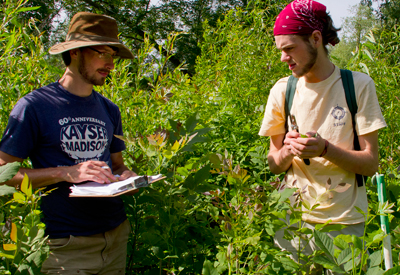 [/caption]
He and Thomsen are experimenting with a variety of fences around 3,000 square-foot sections of trees.His master’s thesis will offer data on which fence is most effective and economical — a plastic ribbon fence sprayed with natural chemicals, a mesh fence or a solar-powered electric fence.
“I feel like this research could be really valuable to land managers,” explains Cogger. “It’s a nice way to apply science knowledge we have.”
Thomsen also sought out undergraduate biology student Andrew Voelkel to help with the research.
“She learned I had a predisposition to getting dirty in the woods,” jokes Voelkel.
In all honesty, the biology major is grateful for the opportunity to be so involved in research at the undergraduate level —
[caption id="attachment_101" align="alignright" width="400" caption="A solar powered electric fence is one option researchers test to keep deer out. "]
[/caption]
He and Thomsen are experimenting with a variety of fences around 3,000 square-foot sections of trees.His master’s thesis will offer data on which fence is most effective and economical — a plastic ribbon fence sprayed with natural chemicals, a mesh fence or a solar-powered electric fence.
“I feel like this research could be really valuable to land managers,” explains Cogger. “It’s a nice way to apply science knowledge we have.”
Thomsen also sought out undergraduate biology student Andrew Voelkel to help with the research.
“She learned I had a predisposition to getting dirty in the woods,” jokes Voelkel.
In all honesty, the biology major is grateful for the opportunity to be so involved in research at the undergraduate level —
[caption id="attachment_101" align="alignright" width="400" caption="A solar powered electric fence is one option researchers test to keep deer out. "]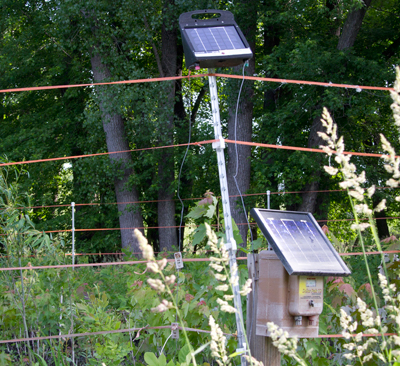 [/caption]
an opportunity in many of UW-L’s academic programs. His task conveniently builds on Cogger’s research. He clips tree seedlings to simulate deer bites in a separate section of the forest. Then he compares how different amounts of deer browsing and the time of year affect tree growth.
“You need to really think like a deer – like you’re eating a bag of chips from top down,” he explains as he clips leaves from a small tree.
Voelkel’s research could also assist land managers like the US Army Corps of Engineers in deciding how to use fences. Voelkel’s research is funded by UW-L’s Dean’s Distinguished Fellowship program. The innovative program fosters collaborative research between undergraduate students and faculty mentors. The student gains research experience and earns a stipend.
“It’s a great way that our college is supporting undergraduate research,” explains Thomsen. “I could seek out student volunteers, but I would much rather see students get paid for their hard work.”
[caption id="attachment_110" align="alignright" width="400" caption="Meredith Thomsen points to trees starting to come in area where invasive grass was killed. "]
[/caption]
an opportunity in many of UW-L’s academic programs. His task conveniently builds on Cogger’s research. He clips tree seedlings to simulate deer bites in a separate section of the forest. Then he compares how different amounts of deer browsing and the time of year affect tree growth.
“You need to really think like a deer – like you’re eating a bag of chips from top down,” he explains as he clips leaves from a small tree.
Voelkel’s research could also assist land managers like the US Army Corps of Engineers in deciding how to use fences. Voelkel’s research is funded by UW-L’s Dean’s Distinguished Fellowship program. The innovative program fosters collaborative research between undergraduate students and faculty mentors. The student gains research experience and earns a stipend.
“It’s a great way that our college is supporting undergraduate research,” explains Thomsen. “I could seek out student volunteers, but I would much rather see students get paid for their hard work.”
[caption id="attachment_110" align="alignright" width="400" caption="Meredith Thomsen points to trees starting to come in area where invasive grass was killed. "]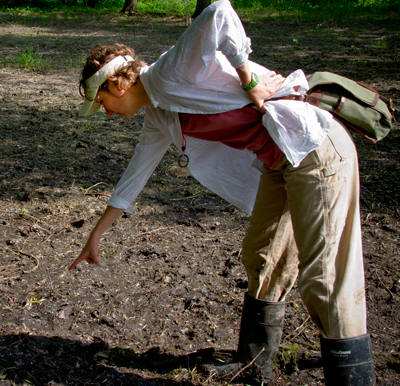 [/caption]
And in the process of all this research and learning, the three hope to help out mother nature too.
“Basically what we are doing with Meredith and the students is reestablishing a next generation forest that will be there hopefully for another 70-80 years,” explains Urich.
See more photos of Thomsen, Voelkel and Cogger's research.
[/caption]
And in the process of all this research and learning, the three hope to help out mother nature too.
“Basically what we are doing with Meredith and the students is reestablishing a next generation forest that will be there hopefully for another 70-80 years,” explains Urich.
See more photos of Thomsen, Voelkel and Cogger's research.
